Modern Wargaming: Conflict In The Ukraine Part Two – Civil War In The Donbas
November 2, 2015 by crew
Welcome to Part Two of our continuing article series on modern wargaming, specifically the recent conflict in the Ukraine. In Part One, we discussed many of the pros and cons of “current-conflict” gaming, and a summary background of the Ukraine conflict.
Now we push forward into the summer and early fall of 2014, looking at some of the more pivotal engagements of this conflict, and discussing in greater detail what gaming can teach us about the specifics of modern warfare.
THE DRIVE ON SLOVIANSK (July 3rd, 2014)
Due in part to problems in funding, supply, morale, and corruption, the Ukrainian Army was relatively slow to react to the uprisings in the self-proclaimed Donetsk and Luhansk Peoples’ Republics (DPR and LPR, respectively). Once the Ukrainian Army got moving, however, they did so in a big way.
A powerful drive was launched southeast between the rebel strongholds of Donetsk and Luhansk, aimed at dividing the rebels and cutting them off from Russia, from whom they were suspected of receiving support, recruits, and supplies. One of the towns in the way was Sloviansk, a known rebel haven.
The town was soon surrounded by Ukrainian Army, National Guard, and “volunteer militia” forces. Although President Poroshenko offered a ceasefire, this was never observed around Sloviansk. DPR separatists repeatedly fired on Ukrainian forces, who deeply resented their own government for tying their hands with a ceasefire.
Finally, the Ukrainians launched a new offensive against Sloviansk on June 3rd. Renewed fighting raged for the better part of a month before the separatists started to break. Ukrainian troops pushed into Sloviansk itself during the first week of July, which is the engagement we’re featuring in the third simulation of our series.
The government push into Sloviansk was a large operational undertaking, involving perhaps up to 15,000 troops of the Ukrainian Army (95th and 25th Brigades), National Guard, and supporting volunteer battalions. Up to 500 tanks and APCs may have been used. If there was any doubt regarding the gravity of the situation in the Ukraine, it was gone now.
The pro-Russian separatists finally withdrew from Sloviansk on July 5rd. In the aftermath, government forces continued their push down through Artemivsk and toward Debaltseve, still intent on separating the DPR in the south-west from the LPR in the north-east, and preventing them from supporting one another.
Trouble, however, was brewing to the east. Already there were strong suspicions that Russian support for the separatist rebels was coming over the border. Well-armed and armoured professional soldiers, notably free of insignia, started to appear in the conflict area, soon earning the nickname of “Little Green Men.”
NEW FRONT AT NOVOAZOVSK (August 26th, 2014)
As fighting continued into August, there could no longer be realistic doubt that Russian soldiers had entered the Ukraine and were fighting alongside DPR and LPR separatists. Satellite photographs showed Russian armoured columns, including BTR-90 and BMP-3 armoured personnel carriers, T-80 battle tanks, and self-propelled artillery.
Russian soldiers were also taking “selfie” photos and posting them on VK, a social media site based in St. Petersburg. In interviews, separatists freely spoke of Russian troops fighting alongside them. President Putin even awarded the Order of Suvorov to the 76th Guards Air Assault Division...for a battle that supposedly “didn't happen.”
One of these incursions came in the south, near the coast of the Sea of Asov. A column of Russian armoured vehicles came across the border and supported local separatists in their assault into Novoazovsk. This was an important town because it controlled the road to Mariupol, a large industrial city just twenty miles further west.
Ukrainian National Guard and militia were unable to hold the town for long. In interviews, National Guard troops bitterly lamented their lack of heavy weapons and armoured vehicles. Meanwhile, fleets of modern tanks and APCs were driving down Kiev streets in Ukraine’s Independence Day parade, gear that was sorely needed at the front.
In general, the soldiers of the Ukrainian Army was not terribly well supported by its government or its people. Fund-raising drives had to be held on Facebook and other social media sites so they could have flashlights, web gear, rain ponchos, and body armour. Their weapons dated back to 1988, and one batch of ammunition was dated to...1947.
All this from a country that until recently was one of the fastest-growing arms manufacturers in the world. The T-84 “Oplot” battle tank has advanced explosive reactive armour, ground search radar, ballistics computers and a gyro-stabilized main gun.
Yet these were sold for export and profit, while their own army faced Russian T-80s with upgraded T-64s that were sometimes forty years old.
ESCAPE FROM ILOVAISK (Sept 1st, 2014)
Perhaps the most telling evidence that Russian support had truly entered the equation was the sudden string of reversals suffered by the Ukrainian army in August and September, 2014. The most grievous of these came at Ilovaisk, where a sizable pocket of Ukrainian forces were surrounded by pro-Russian (and allegedly Russian) forces.
Details are very murky here. Some sources claim that in addition to various militia and National Guard units, the Ukrainians also had elements of the 79th and 72nd Guards Mechanized Brigade in Ilovaisk. Others claim that Ukrainian Army forces “never came to help” the embattled militia and National Guards troops in the town.
Whatever the case, the Ukrainians were soon in very deep trouble. In late August, a deal was struck that would allow the Ukrainians to evacuate through a “green corridor.” However, this didn’t happen. As the Ukrainians started to move, someone opened fire.
On one hand, it’s tempting to say that the separatist rebel militias, some of which have a less than perfect human rights record, pulled the trigger. In militia-driven conflicts around the world, these ad-hoc forces can sometimes commit acts that a disciplined, trained, and accountable army would not.
On the other hand, the attack on the evacuating Ukrainian convoy seems to have been carried out with great precision. Video footage from the site show turrets are blown completely off of tanks and APCs bowled over. There are no scorch marks from “misses,” the area was not simply blasted with indiscriminate “Grad” rocket fire.
Chillingly, it’s almost certain that a “real” army did this. The Ukrainians say they lost over 300 men in this tragedy. Pro-Russian sources say it was over a thousand.
In any event, the disaster at Ilovaisk sent shockwaves through the Ukrainian military and government. The Ukrainian Defence Minister would be forced to resign in October. Meanwhile, it’s been suggested that this calamity, along with other setbacks, helped compel the Kiev government toward a cease-fire agreement being worked out in Minsk.
THE MINSK PROTOCOL (Sept 5th, 2014)
In Minsk, capital city of nearby Belarus, a cease-fire agreement was signed on September 5th between the Ukraine, the Russian Federation, the DPR and the LPR. The agreement was reached thanks to facilitation by the Organization for Security and Co-operation in Europe (OSCE).
However, within two weeks of the signing, repeated violations were committed by soldiers on both sides of the conflict. Meanwhile, the separatist republics set up government elections in November. While these elections were widely supported by the local populace, they weren't recognized as legitimate by the international community.
Thus ends Part Two of our Modern Wargaming; Conflict in the Ukraine series. Response to our first article was certainly spirited. It may not be for everyone, just please bear in mind we’re not “making sport” of any of this. If anything, we’re raising awareness of these issues (at least in our little community), and trying to learn something about how these conflicts unfold.
If you would like to write an article for Beasts of War then please contact me at [email protected] for more information!
"Well-armed and armoured professional soldiers, notably free of insignia, started to appear in the conflict area, soon earning the nickname of “Little Green Men”..."
Supported by (Turn Off)
Supported by (Turn Off)
"...fund-raising drives had to be held on Facebook and other social media sites so they could have flashlights, web gear, rain ponchos, and body armour. Their weapons dated back to 1988, and one batch of ammunition was dated to...1947"
Supported by (Turn Off)









































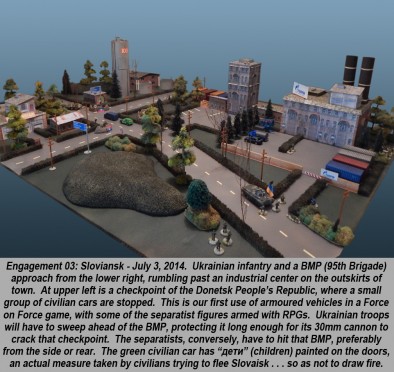

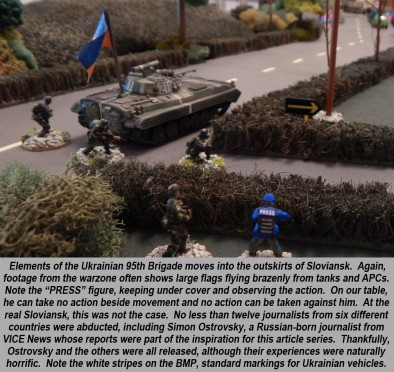
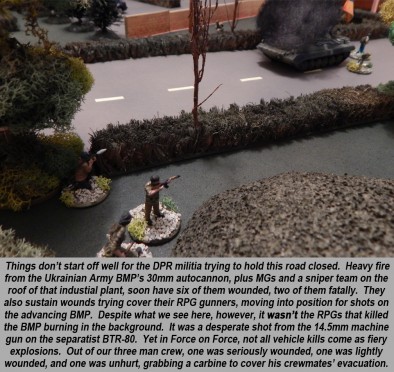
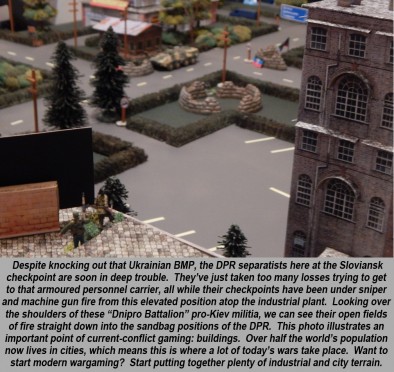
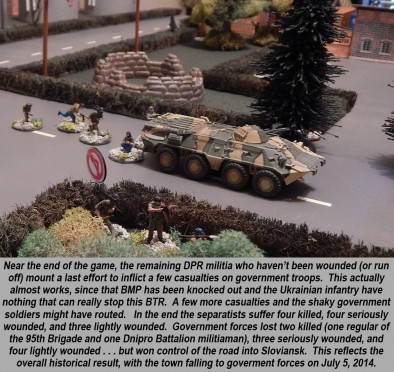
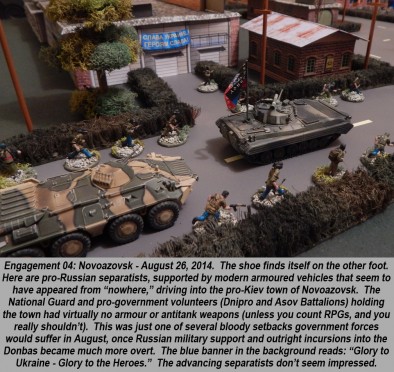

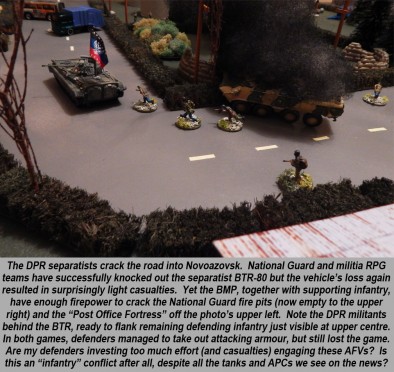
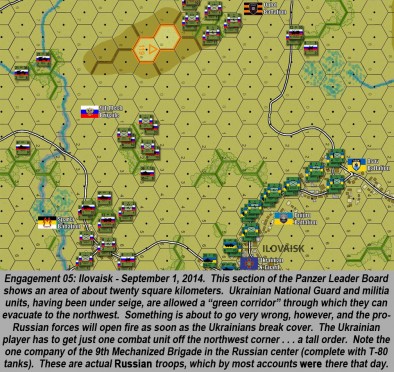
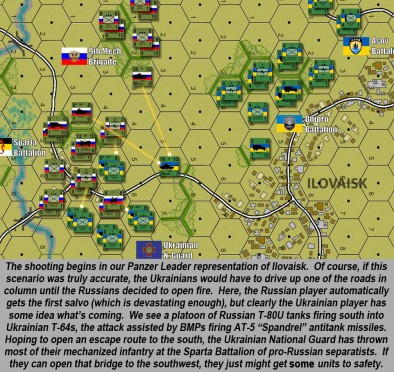
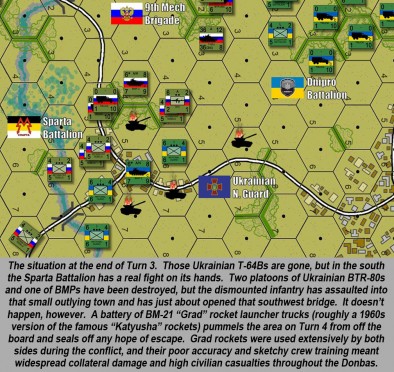
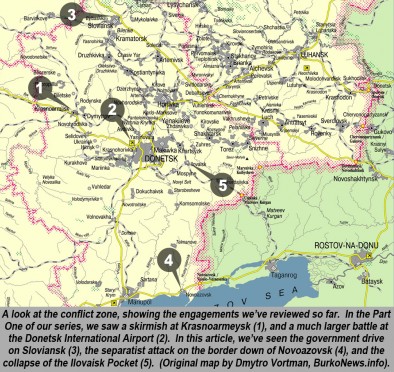


































Another great historical analysis @oriskany . Panzer Leader is a great tool for showing large scale deployments and battles, and it looks like you’ve done a fair bit of work on terrain over the last while for some of the skirmish engagements! Well done!
Just occurred to me that this conflict is more personal than I thought: my step-son will be deploying there shortly!
Thanks, @cpauls1 . Is your step-son going to be part of the NATO contingent in / around Kiev? I know we sent 300 paratroopers of the 173rd Airborne Brigade last may (March / April) to train and advise. I also read Britain has followed suit with 75 more. http://america.aljazeera.com/articles/2015/4/17/us-sends-300-troops-to-ukraine.html Sure enough, at the bottom of this thread is the sentence: “The United Kingdom is also deploying some 75 troops to Ukraine to train government forces there, while Canada announced Tuesday that it will send 200 trainers.” I honestly did not know Canadians had deployed as well. All the more reason… Read more »
We have other contingents going as well, but in a more “operational” capacity. I’ll leave it at that 🙂
Of course, that may all change now that we’ve voted in the most idiotic Prime Minister and government in history, but that bit of politics is a discussion for another thread 🙂 .
Canadian politics, @cpauls1 ? Yeah, I’m leaving that one alone. At least until I write the “Hypothetical Canadian Civil War with covert US involvement” article. Totally kidding, of course. 😀
I’m in @oriskany , if I ever get this @#$%ing MS done. Not sure how I feel about Donald Trump putting his feet up in the House of Commons, but couldn’t be worse than what we have now 🙂 .
Oh God, @cpauls1 . If Trump wins down here, I might find myself defecting on the Canadian side. 😀
It seems a little distasteful to be playing a game about an ongoing conflict. I might be out of line for saying so, It just struck me as such. The battlefield looks really good though. Maybe I’ll become comfortable with the idea of modern conflict eventually.
Needless to say, I (and many others) respectfully disagree 100%.
@drathmere no more so than any other wargame in my opinion, only difference is that the conflict is current, rather than another generations war. War is war, people die in horrendous circumstances. The sheer quality of writing and research in this article shows the respect the author has for the topic, never mind the impossibility of getting authoritative information on this conflict. As mentioned in the first part of the article (which i cannot recommend highly enough), there are many ways to “play” war games, you of course have your objective/points/inflict casualties ways of playing, which is what is most… Read more »
Thanks very much, @nakchak . Definitely appreciate it. We’re certainly “learning” a few things in the course of these engagements, like how tough Ukrainian nationalist missions are with more and more Russian armor entering the table. Seriously, RPG teams have been worth their weight in GOLD. Now that we’ve “been” there and “faced the same challenges” (in a 100% completely vicarious way, of course), we’re seeing just how real the calls were from the Ukrainian military for military support (especially with their own government and people doing such a lackluster job). One reason I picked Force on Force for these… Read more »
Wonderful analysis and another great article.
Thanks, @mrharold ! 😀
Not just the quality of writing or the research, but this guy has been to war and seen it all for real.
Thanks as always for the great support, @unclejimmy . But yes, a USMC veteran, in the interest of full disclosure and honesty, never been close to actual combat.
Seen some grisly “aftermath” stuff, though. More than enough to take the material with seriousness and gravity.
If one area of wargaming is in bad taste then all wargames shoud be. However, it is, after all, just a game.
@oriskany cant wait for part 3, i am not exaggerating when i say that reading this series has made something “click” for me, never really saw the appeal to historical (perhaps “reality based” is a better phrase) gaming before, but now i am very interested in giving it a go!
Thanks again, @nakchak . 🙂 I definitely like Historical, or “reality-based,” as you say. That said, I do enjoy some sci-fi (Star Wars and Star Trek related stuff, or other ‘verses heavily influenced by them). Even then, I usually find that I’m drawn to them as an excuse to play “naval” battles that never took place historically. 😀 For modern-setting, our biggest challenge (strictly from a GAMING perspective) has been terrain. So many of recent and/or current conflicts are taking places in heavily built-up areas, and I’m not sure if other agree, but city terrain for me seems to be… Read more »
@oriskany
One idea for terrain although i suspect 28mm isnt a suitable scale for this idea, would be micromachine playset’s, not the recent rubbish, but the late 80’s early 90’s toys, stuff like this: http://www.ebay.co.uk/bhp/micro-machines-city
I suppose printing out pictures of the cityscape from google earth, and sticking them to cereal boxes would be cheating?
As for my own historical interests, i tend to read a lot about WWI, Vietnam and Recent world events, although as i mentioned prior to your articles i had never considered experiencing them vicariously through the medium of gaming before. That may well change now 🙂
Actually, @nakchak – a lot of my cars, roadsigns, fuel tanks, trailers, etc . . . are Matchbox / Hotwheels, actually “cheaper” brands from the local drug store because they make “normal” looking cars and not hot rods and racing cars. 😀 The scale is a LITTLE off . . . but not too much. Cereal boxes, you say? I certainly hope that’s not cheating because that’s what a lot of these buildings are (well, iPad cases, shipping boxes, gift boxes, that silo is an old holiday gift can for a bottle of Southern Comfort. 😀 Smaller ones are small… Read more »
Heh the cheating was about printing streetview images and sticking them onto the box ;), i am a big fan of “found” terrain, i.e. found a use for it, lost count of the number of refineries i have made over the years from pringles tubes, drinking straws and ATX PSU’s… (just discharge the caps before use, unless you want to tase your opponent, in that case charge them up before battle commences;) ) I have found CD cases to make quite good tower blocks, especially the totally clear cases, just mask a suitable window pattern onto the sides and glue… Read more »
Dude, that idea of the clear CD cases behind a building skin for a “window” effect is actually pretty sweet. Thanks, @nakchak , I may have to use that. 😀
I hope no bottle of Southern Comfort was injured or inhumanly treated during the production of this article series. 🙂
No, @jamesevans10 – but some “So Co” bottles were definitely emptied in the making of this (and other) series. 😀
A whole painted army has a beauty of it’s own even if the individual normal soldiers are not shaded or highlighted. I think the same goes for buildings when they are used in large numbers. While an individual building model may not be a work of art a table full of buildings certainly is. 🙂
Nice article, mate. Tastefully done, as always.
Thanks, sir! 😀 We’re doing our best.
Excellent article. I have learnt more about the conflict from you than from any of the news bulletins and articles that I have seen. Keep up the great work.
Thanks very much, @gremlin . Two articles down, two more to go. 😀 We’ll be covering some of the fighting that’s stretched into 2015, the Minsk II Protocol, the eventual “wind-down” of widespread combat, and maybe a few “take away” points on what makes modern combat “modern.” Of course technology is obvious . . . but really . . . is it? Not in ALL conflicts, we’re finding.
so far so good.
Awesome, @radegast. Thanks. 😀
Cannot thank you enough for firstly continuing with this series mucker. Secondly with out doubt your work is as best it can possibly reflect a war that is as current tomorrow as it is in recently fought conflict(s). A real art form of a great worded piece and as always done with taste as well as respect for any involved.
Thanks. @chrisg . As far as why we **might** not have continued . . . When I first “soft-pitched” this idea to the BoW team, we had a quick Skype and the general idea was: “let’s try it and see how it goes.” Two XLBS episodes ago, Warren characterized the series as an “experiment.” So when the first article went up, after the first day’s feedback I reached out to the team again and said “hey, we’re running about 85% positive (at the time, 27 out of 32 comments that weren’t mine), should we keep going?” The BoW team wanted… Read more »
Well written, Informative, and tastefully done. Now I just envy your free time to do all this. 🙂
Thanks, @silverstars . Don’t envy me too much. What free time I have these projects consume completely. No worries, though, I always take 6-8 weeks off between 8-week project. But “during a run,” it’s work, sleep, eat, write/graphics/research . . . not necessarily in that order. 😐
Free time? No, its called should be sleeping time and should be eating time 😉 You mini’s gamers have some seriously skewed priorities. “Hmmmm I could sleep or I could dry brush all my metal buildings and give them rust.”
Sheesh, all this because I was eating dinner the other day with the fork in one hand, and the “rust brush” in the other. That bridge had to be finished! @Unclejimmy was waiting! 😀 😀 😀
This is a battle you can’t win. Suggested next move – Total surrender! 🙂
Some interesting times back then every day a ceasefire was broken somewhere most of the time no one knows who was to blame?, love the table pictures @oriskany
Thanks, @zorg . I’m really becoming something of a fan of 20mm. I’ll probably always stick to 15mm for WW2, simply because I like larger battles and I have 300+ minis already. 🙂 But for smaller, modern skirmishes I’m slowly converting to 1/72. I honestly can’t keep track of the ceasefires in the Ukraine. Of course there are the “big ones,” Minsk and Minsk II (Sept 2014 and Feb 2015, respectively), but there were many many others in between which quickly broke down. Even now there are small violations every couple of days, and people still being hurt and killed… Read more »
As someone new to modern figures and larger scale pieces, I have to say I am impressed. The amount of detail you can fit on the infantry is amazing (stripes on pants, blue armor on police, etc.) Also the larger scale on the buildings allows you to add the signs which, for me, make the board. They truly turn it from and old “city” board to an Eastern European board. Your writing is always informative while still being entertaining, however your boards are really what catch the eye and make you want to read about the game that went with… Read more »
Thanks, @gladesrunner . Although in truth, those signs are just to “punch up” what I was afraid were rather plain-looking buildings. 😀
All too quickly dismissed as scatter scenery. Yet nothing places a battle to its place and time than scatter scenery. Just the simple addition of a movie poster locks down the time. Street lights and road signs have similar effect. I am a firm believer in that your table should get just as much time as you place in the models and their bases as it makes for a total visual experience. 🙂
I know what you mean, @jamesevans140 and agree. To save myself money, time, storage space, and most importantly sanity . . . 🙂 . . . I keep this signage detachable. To give a WW2 example, a general “restaurant” type building can a French cafe in Normandy, or a gasthaus in Germany, simply by switching out the sign hanging out front. Presto, the whole board is now in a different country with “authentic” detail.
Well I must say the second instalment lived up to the high expectations that was placed upon it by the first article. Very well delivered narrative. The old maxim of go into the countryside and swim through the people like fishes through water is now mostly behind us now. Besides the migration of the population from the countryside into the city that has occurred since the 60’s is our every growing dependence on electronic based high technology. You simply don’t get good Wi-Fi in the countryside. This raises the question could a modern war continue if we experienced solar flares… Read more »
@jamesevans140 “You simply don’t get good Wi-Fi in the countryside” not true, have been known to string hotspots through trees, with 300m runs of cat5e/6 with a repeater over a couple of fields. Admittedly i am networking geek and never grew out of climbing in trees but still 50MB/s says good wifi in middle of no where 😉 As for reliance on fat pipes, most military grade field comms infrastructure is actually quite low on data bandwidth requirements (one of the reasons military grade encryption is based on 20+ year old technology) essentially if you have the bandwidth to receive… Read more »
Augh, @jamesevans140 ! I was JUST LAST NIGHT writing a rather big section on the difficulty of modern tanks in cities (Part Three contains separatist T-72s advancing through the Kyivs’kyi District toward Donetsk International Airport). Do you have a webcam in my office? Creepy. 🙂 Thanks for the comments on the Panzer Leader boards. I will sloooowly convert all of Beasts of War to Panzer Leader! The cult lives on, bwahaha! 😀 And thanks for the comment on the article format. This was the thirty-third article done for Beasts of War, it’s safe to say we’ve hit a stride. Additionally,… Read more »
BoW has a style guide @oriskany ? Sheesh. That would help!
Yeah, the basics. Word count, use the Queen’s English (all those extra “u”s . . . I guess to add a bit of “colour” to the text 🙂 ), how many images to include, etc.
Do you have a link @oriskany? Couldn’t find it. After I get this effing MS out of my hair I’ll likely do a few how-to articles with my floating castle. Queen’s English, you say? Is there any other kind? 😉
Uhhh . . . there’s, like REAL English? As in . . . why doncha learn to talk ‘Merican good? Duh. 😀
Seriously, I think it’s a .pdf. I’ll e-mail it to you.
lol. Thanks @oriskany . Ah hope’s ah can make somethin’ as purdy as this 🙂 .
If I can get through the inch-thick Times style guide (advanced editing textbook) I’m sure I can get through BoW’s!
I know the feeling. The one we had for reference and web publishing at work was about that thickness, but a big part of that was confidentiality-related. “Please don’t tell our competitors about the price points on our upcoming releases and products.” Wow, really? Thanks.
Sent the style guide. 😀
OMG, the thing has more holes in it than Swiss cheese. Ambiguous enough for my purposes.
As a professional writer for 12 years and having had to BUILD a couple of these writing guides for companies, I actually found BoW’s style guide a breath of fresh air. Word counts, number of images, a very few things to NOT discuss, a general summary of style (Queen’s English, gaming issues, etc). How to include a few informal terms specific to expected content. Done. No rambling about non-competition clauses, confidentiality agreements, indemnification protections, CCU licenses, public domain, blah-blah-blah who gives a s**t- do you ever get tired of the sound of your own voice. Frankly, stuff like this is… Read more »
Peak-a-boo. 🙂
Thanks @nakchak but my statement of Wi-Fi in the country was a generalisation encompassing the entire world every inch of it and was not considering the exceptional few places. Well aware of bandwidth so no need to go there. In situations of civil uprising the non government side would have to rely on G3 or less which covers a large portion of the population but falls well short of covering the world away from population centres and remember I am generalising here. 😉 Which is why many non government organizations of civil unrest are tied to city and towns. It… Read more »
I’m actually not very knowledgeable about these “EW” kinds of questions. I’ve definitely heard most of what your talking about. I know many modern AFVs are “EMP-hardened” which is supposed to make their electronics resilient to some of these things, but a small battlefield tactical nuke is one thing, the sun throwing a temper tantrum is something else. 🙁 Re: Challenger visual engagement: I know what you mean about systems failure in combat, and how nothing will ever truly replace the “Eyeball Mark 1.” This was one of the things I was hoping to bring out in this series. When… Read more »
One of the biggest issues that would face a militia if they captured a current generation tank would be care and feeding of the beastie. Just the simple act of aligning a gun barrel of say a M1 to its targeting systems requires laser systems and a specialised PC. The M1 starts screaming feed me after 4 to 5 hours of operation but at least its not concerned about it’s diet, just that it will want lots of it. There are few mechanics that can strip down and service a jet engine. Then there is the little issue of getting… Read more »
@jamesevans – “An analyst once described the M1 in war as going to war with one foot stuck in a bucket.” Ha! I know exactly the guy you’re talking about. Curly dark hair, kinda young? He was in “Generals at War” and some other series. I always find him a little annoying, just his speech, voice, and body language. He definitely knows his stuff, however, and makes the occasional memorable turn of phrase. I remember what he was talking about in this documentary. In addition to everything you’re saying, there was the additional point of: “Here’s what the RPG-armed Iraqi… Read more »
Feels wrong on so many planes. The battefield is very nicely done. The article is great. But I just can´t game this. There might be people who lost their loved ones to this conflict watching me and my buddies having fun playing the game (wich is the conflict). I´m sorry it doesn´t seem right. There are so so many wargames in all periods that we should´t need to do this. I might be wrong and I might be “bleedy” beacuse Im a dad but many of those who died in this conflict was also someones dad, not just lead or… Read more »
I hear what you are saying, if the articles showed a flippant disregard i would also agree, but in the authors defense what i see here is more of an analysis of the (ongoing?) conflict using miniatures, in that respect how does it differ from bomber command pushing planes around a huge map? or a diorama in a museum?, other than a ruleset is employed to provide the mechanics of simulation, and offer the opportunity to better understand the decisions that were made/forced by circumstance?
I appreciate it, @nakchak . 😀 Some people just aren’t going to get it, and that’s perfectly fine. I will say I find the “dad” comments particularly telling. Warren, father of three, spent a chunk of last XLBS supporting this article series, but I guess his opinion as owner of this site has been overruled. To say nothing of the step-dad we have at the top of this thread, who also supports this series and what it’s trying to do, and who actually HAS someone deploying into this conflict zone. I suppose his point of view should also bow to… Read more »
am a dad too, admittedly my daughter is only 13months old, but i certainly wouldn’t keep her away from exploring history and conflict if that’s whats she’s into, if anything so that knowledge of the past explain the present, and hopefully guides the future, truth be told as long as she asks “How” and “Why” a LOT then i will be happy 🙂
“Why” is the question. In the end, perhaps the ultimate question. That’s where all the power is, and why it’s often so dangerous. All the way back when we were kids . . .
“You have to go to school.”
“Why?”
“Eh . . . because I said so!”
Once you got to “because I said so,” that was when you knew you’d won the argument. 😀
Great article/series. I thought I was fairly well informed about the conflict, but you’ve filled in a lot of details I didn’t know. Keep up the good work. Regarding the question of ethics or taste on gaming modern or current conflicts.. the thing is, pretty much every kind of wargame can be interpreted as offensive, controversial or morally wrong to some people. World War 2 is a popular period, but does playing that for fun trivialise the horrors of the Nazi regime? Ditto for classic Pulp gaming where explicitly Nazis (as opposed to merely German soldiers) are a popular opponent.… Read more »
Thanks very much, Doctor. 😀 You know, I could try to add to what you say, but pretty much you say it all. So I’m gonna thumbs up and leave well enough alone. Thanks again for the support and the great post. All I will say is that as a USMC vet during the Gulf War (sadly yes, I’m that old), I had friends in Bahrain, at Khafji, and Kuwait City and up the Basra Road. I remember when the very first dedicated wargame based on the Gulf War came out (Line in the Sand, I can’t remember who published… Read more »
Classically it is the base of a figure that was the important piece not the figure itself. Most common the base occupied a scale area occupied by a platoon and represented a platoon of real men. In modern times it is all about the figure and the respect for the real men has somewhat given way to playing toy soldiers. So it is no wonder people get confused when the wargame is used in its classical role as an analytical tool, like @oriskany is doing here, and not merely playing toy soldiers. The word Orc or Orcha is a Saxon… Read more »
@jamesevans140 – you write: “Most common the base occupied a scale area occupied by a platoon and represented a platoon of real men.” – – – or the size of the counter . . . the HEX and the counter. When you start talking platoon-sized pieces, the cult of Panzer Leader whispers to you from the darkness. Shhh . . . don’t resist, James. It’s so much better if you don’t resist. 😀 😀 On a more serious note, the idea of wargames used “classically” used as analytical tools of course goes back (as I’m sure you know) to the… Read more »
@oriskany get out of here you map heathen! 🙂 🙂 Some wargame historians push this date back to medieval times when kings played a game similar to modern chess but had about 4 times as many squares which could be coloured to represent terrain types and the had a number of different playing pieces. Modern chess does descend from this game. Others push it back to the Romans as many military figures of about the right size has been found. However there is no evidence linking the figurines to a game. The Romans were big on figurines. You could buy… Read more »
We’ve run PanzerBlitz/Leader with the two room “double blind” system. I was running it (i.e., the referee not playing). never have I been so glad for an iPhone to take quick photos of one player’s map, so I could run into the next room and update the other player’s map if anything was spotted / engaged. Kriegspiel, that was the name of it. Couldn’t think it off the top of my head earlier. “Little Wars” – that was H. G. Welles, wasn’t it? Cheated? Hey, having a battle at Midway was far from “our” idea. We could say the same… Read more »
@oriskany 1. Yes Kriegspiel was the German primary war game rule set leading up to WW1. 2. Yes it was HGW. He also wrote an expansion to it but I cannot remember it’s name off the top of my head, I can chase it up for you if you want. People know HGW via science fiction whoever he turned his hands to my things including war analyst. The War of the Worlds was an off shoot of his study into an invasion by a vastly technologically superior adversary. The germs were not a big insight. The Victorians were into germs… Read more »
I’ve always read a lot into HGW’s “predictions” in War of the Worlds. Chemical warfare by the Martians, biological “warfare” by . . . well, by accident or Mother Nature or however you want to interpret that part of it. The heat ray (lasers) and the some of the shielding was described as causing incoming shells to explode prematurely. The only big thing he seems to “miss” is radio. He has the Martians blasting those very loud horns at each other as a way of communication – but of course the novel was 1898 . . . 1896 . .… Read more »
@oriskany HGW was an insightful man for his times. At the time of writing radio was still be argued if it could work much like EM engines are today but if it was only written a few years later I think he would have included it. Just prior to writing it as I mentioned he was touring the lecture halls discussing an invasion by a technologically superior force. The foe were the Martians but the lecture was as factual as he could make it and perhaps this flowed on into the book. He actually regretted his Martians lecture as no… Read more »
Agree 100% @jamesevans140 about the tech advances and visionary importance of the early 1900s. When I’m in the mood to pick a fight, I usually roll this argument over at the tech company where I work, where they think they’re doing “so much” to “change the world.” Compare things invented between (about) 1900 and 1950, vs. (about) 1951-2000 . . . Air plane Car Computer (binary logic driven, as in the Z1 in Germany and the Bronze Goddesses of Bletchley Park). Telecommunications Ballistic rockets Guided missiles Super highways Order-by-Mail commerce The jet airplane The Helicopter The Telephone Plastic Things invented… Read more »
@oriskany Yes the TV was kicking around before WW2. In fact the Japanese attack stopped the roll out of TV as a consumer product. The factories were ready to roll. By mid wall the Germans had TV remotely controlled antiship flying bombs. By late war bold the US Army Airforce and the US Navy had both developed radio control versions of the B-24 that were crammed full of high explosive. The intent was to fly them into heavily fortified ground targets. Both systems used a TV camera that transmitted an image of the flight instruments back to the controlling aircraft… Read more »
Thinking about what the difference between modern warfare now and “modern” warfare from WWII would probably be, I can think of a few major differences. And from here on out I’m discussing what a 1st world power against another 1st world power with roughly the same generation of technology and level of logistics/resources. No asymmetrical warfare as seen in Afghanistan/Iraq. This is a conflict between people with the highest tehnology that current technology can offer. 1. Information- This is a major difference between now and WWII. The Fog of war from the early 20th century is almost completely gone. Between… Read more »
Great post, @silverstars – I think one way I’ve managed to “get away” with doing modern combat on a 20mm table is keeping it militia-based, and small scale. If we were going to do what you’re talking about (“blue-ribbon” army vs. “blue ribbon” army in full-scale battlefield combat) – that’s really tough. I agree with just about everything you say, and might even take one step further to say that miniatures in general might not work. Ranges are something like 3,000 meters for MBTs, easily . . . and 5,000 for most current-generation ATGWs. That’s 300 feet on a 28mm… Read more »
Agree with most of what you say here @silverstars except point 1. Did you know that Iraq has approximately 256,000 boulders that give off the same targeting profiles as a Russian jeep? Missions had to be flown to eyeball these contacts. In many ways today we can get faster into the thickest fog of war than in any time in history. Once we enter the into the immediate battlefield the fog of war generally clears up much better than at anything in history. So our situational awareness is far greater. Your conclusions about similar powers is supported by the fact… Read more »
In regards to @silverstars Point 1, I think I land “between” the two positions. I would agree that a huge amount of “fog of war” has been dissipated. Any kid with a laptop can see any corner of the planet with a quick scan of GoogleEarth. A crude example, admittedly, but I don’t want to write a book here. 🙂 That said, we’ve no sooner removed the old fog of war than replaced it with a new and possible even more opaque fog of war. Not a lack of information, but an overabundance of information. I know I’ve brought them… Read more »
Bottlenecks in the flow of information is a big issue. Staff officers tend to over analyse each incoming piece of intel while their numbers have not been drastically increased. The other issue found in both Gulf wars were old school officers between the dissemination points tended to hoard the intel was it empowered them in the old school way. As these officers are retired and or retrained this issue should clear up. As a creature we tend to be able to handle up to 6 different tasks at the same time reasonably. Other the other hand as you start adding… Read more »
OMG, it’s so hard to read all this, as a recently retired spook. The armchair theatrics is killing me lol. In the 80’s, as a wee tot, I became a retread from the infantry into the G2 world. In 4CMBG, as a corporal, I was one of seven int ops responsible for a brigade of 4500, and also cross-trained with the counter-int types, and did some dirty work on their behalf. When I recently retired as a Warrant Officer, I was qualified as 2IC of an intelligence platoon of 30+ troops, a multi-disciplinary organization that gathered information from an entire… Read more »
“Armchair theatrics?” 🙂 Yes it, called wargaming. Welcome to the hobby. 😀 Just listing some publicly recorded events from recent history and asking some questions. Note the whole back end of my last post ended in question marks. So I doubt I came to any earth-shaking conclusions. 🙂 And I have no idea how a western army or government would do this, but it just seems clear that the Russian government / army / FSB (and I wold say GRU . . . is that still a thing?) . . .DIDN’T do it, at least not sufficiently. “Selfie Soldiers: Russia… Read more »
Well, I just got the chance to sit and read this through in one go. Your best yet, in my opinion. I love the pictures too. Is there anything you can’t do?
Well done. In another place – 500pts!
Wow, thanks, @unclejimmy ! Things I can’t do? Plenty. I can’t code, so I can’t build my own website like BoW (standing by for the 10,000 products that allow you to “build your own website in five easy steps!”) It doesn’t work that way, folks. There’s an industry out there for web developers and web designers. 🙂 Trust me, I’ve worked as the latter, but NOT the former. Huge difference. And apparently I can’t paint infantry very well. I can get the uniforms and equipment okay, but when I try to do the faces / hands / skin it never… Read more »
Love the series (as I did the others you have penned). Question for @Oransky, are you having issues finding the proper vehicles and soldiers in 20mm here in the US, or are you ordering from foreign distributors? My modern gaming so far is skirmish level 28mm, but am thinking about going to 20mm if I continue down this path. I do have a comment/question for those that sound like they are against ‘gaming’ this particular event. Do you feel the same way about gaming Panama, Desert Storm, Balkans, Iraq, or Afghanistan? If not, why? And secondly, where you there? Those… Read more »
Thanks very much, @aloharover – it sounds like we were in at roughly the same time (at least at the beginning). Was in USMC infantry school when Just Cause hit it Panama, December 89. I still remember our platoon marching to morning chow at 6th Regiment messhall at Camp Geiger, and we walked right in with no wait . . . because 6th Regiment had vanished in the night to be deployed down in Panama . . . It was an honestly spooky moment because we were all green-ass boots right out of basic, it was the first wake up… Read more »
I feel like I am breaking the bank with the 28mm stuff. 🙂 But thank you for the info, thank you for the articles, and Thank You for your Service.
Marines are Riflemen 1st
Once a Marine, always a Marine
Semper Fi
Happy Birthday!!
Thanks, @aloharover – Indeed, I’ve just made the jump from 15mm to 20mm . . . and suffice it to say it’s been a journey. I can’t even imagine making the jump to 28mm yet. Glad you like the articles. 😀 As for the “service,” all I did was sit on my ass in an office or warehouse and fill out requisition forms. A little bit of tactical training (everyone had to do it back then) and later as a rifle coach since I tended to score well with the M16A2. I was in and out long before more recent… Read more »